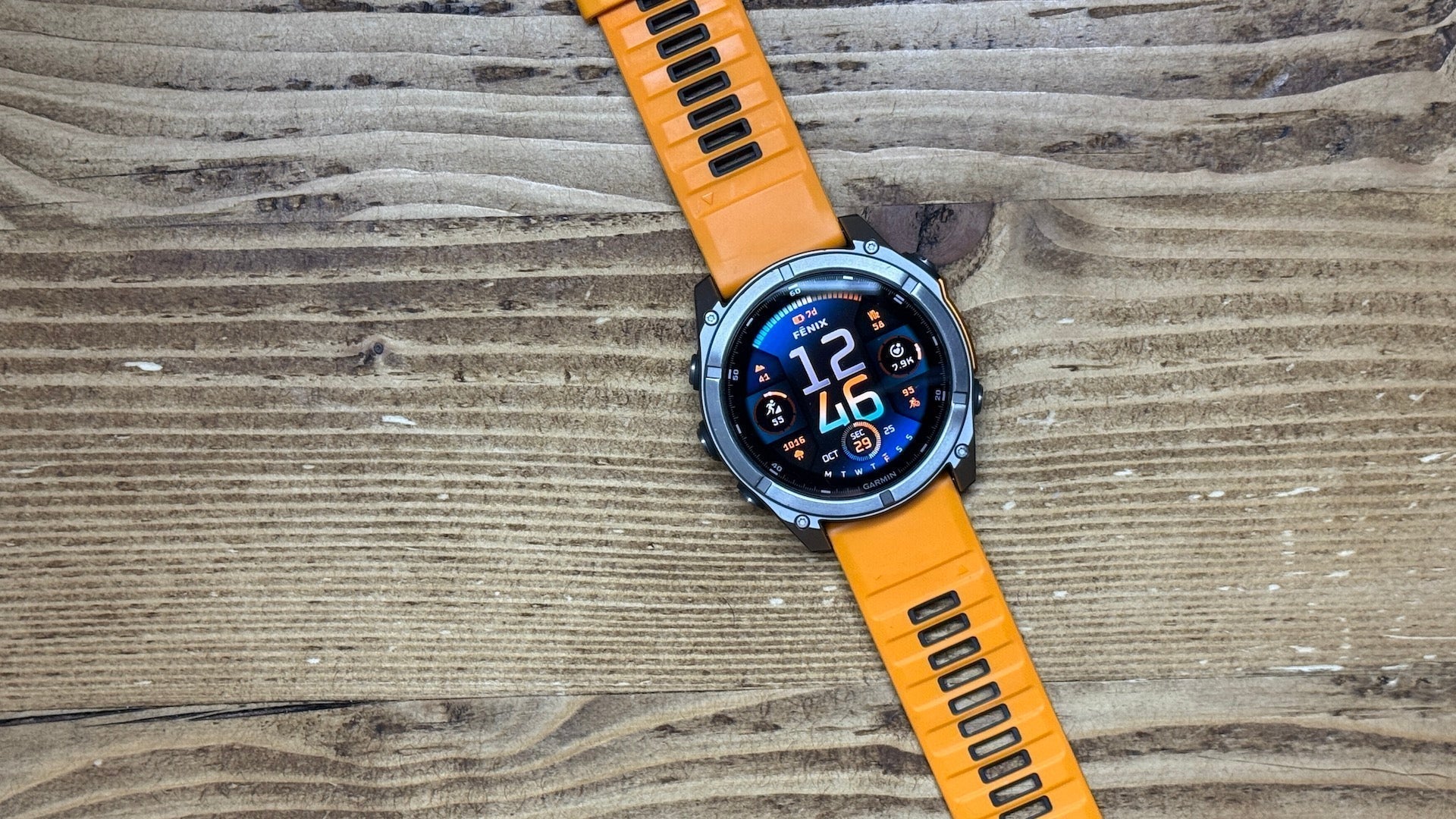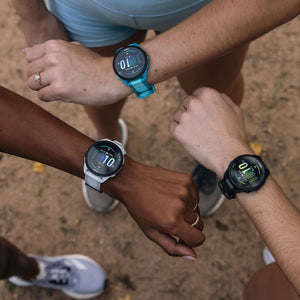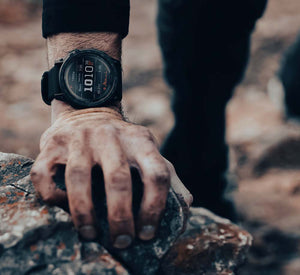
Garmin fenix 8 Review: The Total Adventure Tool?
It packs a killer AMOLED screen, longer battery life, and new voice tools but is Garmin’s new flagship fenix 8 the best running watch you can buy? I tested it for two months to find out.
The Garmin fenix has always been one of the best multisports watches but it just got a whole lot smarter. It’s now hands down Garmin’s most capable, feature-packed, premium run tracker. It comes in a variety of AMOLED and Solar models (more on that later) with upgrades that stack up to a smarter adventure-ready watch.
The new Garmin fenix 8 AMOLED adds a bright, pin-sharp Apple-Watch-esque screen – like the one on the Epix Pro – to reliable tracking accuracy, an impressive GPS battery life and new navigation tools. It also now offers Garmin’s most complete package of smartwatch tools including a new built-in mic and speaker to power voice activation, offline music, contactless payments and the new Garmin Messenger app.
All that comes at a cost, however. The fenix 8 price has jumped up from the fenix 7, surpassing the Enduro 3 as Garmin’s top-dollar tracker.
But is it worth it? And is the Garmin fenix 8 AMOLED the best Garmin running watch you can buy? I spent two months testing the new Garmin watch to find out.
Read on for the verdict in my Garmin fenix 8 review.
Table of Contents
- Garmin fenix 8: An Introduction
- Garmin fenix 8: How I tested
- Models, Sizes, & Prices
- Garmin fenix 8 vs 7: The Big Differences
- Garmin fenix 8 Battery Life
- Running, Fitness, & Health Features
- Garmin fenix 8 Mapping & Navigation
- Easier to Use
- Garmin fenix 8: Heart Rate and GPS Accuracy
- Bottom Line: Should you buy the Garmin fenix 8?
Garmin fenix 8: An Introduction
The Garmin fenix 8 is Garmin’s do-it-all, rugged multisport and adventure watch. This Garmin watch is built to withstand the knocks and scrapes of wilder adventures, with premium materials like a toughened sapphire glass display and a lightweight titanium and Diamond Like Carbon bezel and casing.
It features the latest hardware and sensors, powering the most comprehensive suite of tracking, training, recovery, health and smartwatch smarts in the Garmin GPS watch line-up.
There’s a lot of watch here in every sense. It sits big on the wrist and goes large on features, with everything from detailed training insights, health monitoring and navigation to offline music and contactless payments.
The fenix 8 is a serious tool that tends to appeal to more committed runners and adventurers. If you’re just starting out there’s probably more watch here than you need and you don’t need to spend this much to cover your training and racing needs. There are cheaper alternatives in the Garmin Forerunner range like the Garmin Forerunner 165 that might be a better fit.
Garmin fenix 8: How I tested
For this review, I spent close to two months with the Garmin fenix 8 Solar 51mm. I lived in it, slept in it, and trained with it. I also ran a solo marathon and a mountain ultra, putting it up against the likes of the Garmin Enduro 3, the Apple Watch Ultra 2, and a Polar H10 chest strap.
Models, Sizes, & Prices
There are a lot of watches in the Garmin fenix 8 Series line-up. It can be mightily confusing. But it largely breaks down into three main models:
- The Garmin fenix 8 AMOLED: with that new, big, bright lovely display that comes in glass or sapphire glass and stainless steel or titanium finishes.
- The Garmin fenix 8 Solar: swapping the AMOLED display for the battery-boosting, sun-harvesting skills of a lower resolution Memory in Pixel (MIP) solar display, with sapphire glass and titanium finish.
- The Garmin fenix E: a smaller, cheaper AMOLED model that foregoes Garmin’s latest heart rate tech, the new mic and speaker, the flashlight and has less memory.
Here’s a quick rundown of the Garmin fenix 8 prices and sizes:
- Garmin fenix 8 AMOLED 43mm – $999.99
- Garmin fenix 8 AMOLED 47mm – $1099.99
- Garmin fenix 8 AMOLED 51mm – $1199.99
- Garmin fenix 8 Solar 47mm – $1099.99
- Garmin fenix 8 Solar 51mm – $1199.99
- Garmin fenix E 47mm – $799.99
Garmin fenix 8 vs 7: The Big Differences
The most notable upgrades over the Garmin fenix 7 include that big, bright, colorful AMOLED display. It really punches up your stats, maps and the whole experience. There are also bigger screens on the smallest watches and boosted battery life (in most settings). The improved Solar edition battery life comes from a more efficient solar panel that also takes up less of the screen.
The Garmin dive watch credentials have also improved with waterproofing that lets you drop to 40m depths.
The fenix 8 AMOLED and Solar models now pack a built-in speaker and microphone. So you can take calls, when you have your phone, listen to offline music or have lap splits barked at as you run and use voice controls to start a run or summon SIRI/Google/Samsung assistant or take voice notes.
The price has increased versus the Garmin fenix 7. If you’re thinking about a fenix 8 Solar and don’t care about the new speaker/mic tools, the fenix 7 is definitely worth considering.
Garmin fenix 8 Battery Life
The listed Garmin fenix 8 battery life varies a lot depending on the model and the size.
On paper, generally speaking the Garmin fenix 8 Solar editions pack bigger battery life than the fenix 8 AMOLED. However, that relies on getting the most out of the solar smarts in the best light conditions.
For the fenix 8 AMOLED models, the smaller the case size, the shorter the battery life. But even in the smallest size, the staying power is mightily impressive for an AMOLED multisport watch.
- Garmin fenix 8 43mm AMOLED – 28-49 hours
- Garmin fenix 8 47mm AMOLED – 47-81 hours
- Garmin fenix 8 51mm AMOLED – 84-145 hours
In testing, the fenix 8 AMOLED battery life largely lived up to billing. The average battery burn overnight was as low as 1-2%–only slightly higher than the Garmin Enduro 3. Over a 24-hour period with no runs or GPS usage, the fenix 8 dropped just 8%.
On the run, it excelled, too. A 90 min run in Normal Power mode with the screen set to Always On burned 3%. A 3-hour marathon in Max Accuracy mode / Always On burned 6%.
I also ran an 8-hour ultra at the 5 Valleys Ultra in Normal Power mode with the screen Always On, using energy saving SAT IQ. During that race, the fenix 8 burned 15%. The Garmin Enduro 3 burned 14% with the same settings.
TL;DR: You can enjoy the fenix 8’s excellent AMOLED display without sacrificing too much staying power. If you opt for the reliable raise to wake over the Always On display, you can also get closer to the Enduro 3 levels of endurance. Though if you’re looking for the very best staying power, the Garmin Enduro 3 still wins the day.
Running, Fitness, & Health Features
The fenix 8 doesn’t offer many new tools. But if Garmin has a tool for it, it’s on this watch. There’s too many running, fitness, and health features on the Garmin fenix 8 to list them all here. In fact, there’s more tracking insights here than most people really need.
All the training mission-critical essentials are here including training plans, adaptive coaching and session suggestions, plus training effect, training load, and performance condition readouts. I found the new targeted strength training plans with helpful animations for each drill very useful.
There are tools to help you balance training and life with sleep tracking, Heart Rate Variability, Body Battery (a real time energy level estimate), and recovery time recommendations. All of which comes wrapped up in a handy daily Morning Report.
The fenix 8 is also great for charting your fitness progress with VO2 Max and race time predictor estimates. Plus it offers extra measurements you won’t find elsewhere like Hill Score (how good you are on the ups) and Endurance Score (how good you are at going long).
Garmin fenix 8 Mapping & Navigation
Garmin’s navigation tools are best-in-class and the mapping and routing smarts have been improved on the fenix 8.
In addition to routable offline maps and handy features like next fork routing, backtrack, and time to destination estimates, you can now customize map layers and access dynamic round-trip routing. All that really comes to life on the big AMOLED display.
The ClimbPro tools are also excellent. It was really easy to load my ultra route onto the watch and see how many climbs I had left to eat during the race, along with the profile of my current climb and how many more quad burning feet I had left to climb before I hit each summit.
This watch basically sets the benchmark for navigation.
Easier to Use
Alongside the nicely responsive touchscreen, the Garmin fenix 8 features its familiar five button controls. These are now leakproof. You can choose the touchscreen, buttons–or a combination–to do pretty much everything. So there’s total flexibility, great for when things get too wet or sweaty for the touchscreen.
Everything is fast and responsive and I like the subtle haptic feedback from the buttons.
There’s a wider selection of watch faces and these are now more customizable. The user interface has some quite significant changes, too. It’s now easier to navigate the settings menus, open a preferred workout mode and tweak the settings right before you get going.
On older Garmin models, when you hit the top right button, it takes you to your list of sport modes. But the new nav drops you on a screen with Activities and a couple of pinned preferred sport modes above a list of other tools that you can customize Maps, Phone, Music etc.
These changes won’t trickle down to previous generation Garmin watches.
Garmin fenix 8: Heart Rate and GPS Accuracy
The fenix 8 uses the same multiband/dual frequency and the same Garmin Elevate Gen 5 optical heart rate tech as the fenix 7.
To test the accuracy, I put the Garmin fenix 8 up against a range of watches, including the Garmin Enduro 3, Garmin Enduro 2, and Apple Watch Ultra 2. I also benchmarked the heart rate using a Polar H10 chest strap.
I ran everything from urban 5kms to a tree-covered National Park forest marathon and a remote mountain ultra. I used the Max Accuracy GPS mode that makes use of that multi-band GPS, the Max Battery mode that sacrifices some accuracy for battery life and plenty of sessions using the SATIQ AutoSelect mode that automatically finds the best settings for accuracy and battery life.
The fenix 8 GPS performance was generally solid but not completely bulletproof. Total distances came well within the margin for error on the official race routes, I found the real time pace readouts on par with the other watches and despite some struggles under heavy tree cover, the fenix 8 locks routes as well as any watch.
The optical heart rate was more hit and miss. During most of my sessions it performed admirably against a chest strap. On my marathon test, it captured the steadily increasing intensity almost beat for beat with the chest strap. But it struggled sometimes when I shifted gears during intervals. Or when my effort levels fluctuated on the climbs and descents of the mountain ultra and at aid station stops. It sometimes dropped lower or lurched higher than the chest strap. But that’s pretty standard for wrist-based heart rate.
The upshot: for easy, steady efforts, the optical sensor performs with good reliability. If you’re looking for precision heart rate training in your interval workouts, or want better accuracy when racing, you’ll still need a chest strap.
Bottom Line: Should you buy the Garmin fenix 8?
The Garmin fenix 8 AMOLED is the most capable Garmin multisport watch you can buy. You won’t find a watch with better tracking, training, health or navigation tools. It’s tough, talented, offers reliable accuracy and excellent battery life along with that kick-ass AMOLED screen. Oh and the ever-popular built in flashlight. That’s all great but you’ll have to pay for it.
This is a top-dollar watch. It’s a huge investment and it’s worth asking yourself if you really need all those tools before you buy.
If you already own a fenix 7, there’s probably not enough in the fenix 8 to warrant an upgrade. If you don’t care about the AMOLED display and the new speaker, mic, and voice tools haven’t got you excited, you’ll get largely the same tracking hardware and experience from a cheaper, last-gen Garmin fenix 7.
If you want something more compact and don’t care about the mic/speaker and the flashlight, the fenix E is a cheaper alternative. Or the fenix 7S Solar lands at the same price.
Considering the Garmin fenix 8 vs Enduro 3? If battery life is your top priority, the fenix 8 won’t rival the staying power of the Garmin Enduro 3. Though for many runners, the day-to-day difference might not be that noticeable.
The Enduro 3 price has also dropped below the fenix 8. So if you can forego the AMOLED, the voice tools, and a few other minor bits, the Enduro 3 is a serious alternative to the fenix—particularly the non-AMOLED solar editions.
Weighing up the Garmin fenix 8 vs Apple Watch Ultra 2? Although the clever new voice tools and the interface tweaks nudge this Garmin GPS watch much closer to smartwatches like the Apple Ultra 2 – and it’s smarter than most of its rivals – the fenix 8 is still not a true smartwatch.
If all the life management, time-saving tricks you get on the Apple Watch are your top priority, then the Apple Watch Ultra 2 is still your best bet. Provided you’re ok with a much shorter battery life and fewer sports tracking skills.
If you really want an AMOLED screen but you want to spend less for the pleasure, the Suunto Race and the Polar Grit X2 Pro are two strong alternatives outside of Garmin’s line-up.
About Journalist Kieran Alger
Co-founder of The Run Testers, Kieran Alger is an experienced journalist who has spent more than a decade testing running gear. Regularly found wearing four GPS running watches at once, if it claims to make you run better or enjoy running more, he has probably tested it. He's a borderline obsessed runner with more than 50 marathon and multiple ultra finishes. In 2022, he became the first person to run Europe's river Danube from sea to source, a measly 1,830 miles in 66 days. And still had time to test running gear.
Check him out on Instagram or his YouTube Channel!





























